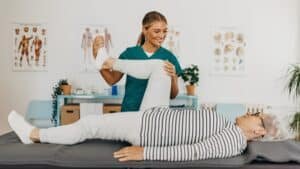
Alison Crouch was not surprised when she was diagnosed with osteoporosis in her early 50s. She has family history. Her mother had “lousy bone density in her early 50s” and was put on medication.
Alison herself had measurable bone loss in her lumbar spine in her early 30s that she was able to reverse through exercise. She developed a professional interest in the condition as she became a certified Pilates instructor and started her movement training company MoveSmart.
But her blue eyes go wide and her hands fly open, too, as she recalls her initial response to the diagnosis. “There was this moment of what am I going to do now? I’m a Pilates teacher! I went through a phase of feeling like a total fraud, went through a phase of being afraid to do anything. I’m also a scuba diver. It involves a lot of heavy gear and bending. We have a sailboat. I had that paralyzed feeling, but now what?”
What Is Osteoporosis?
According to the Osteoporosis Canada website, “Osteoporosis is a disease characterized by low bone mass and deterioration of bone tissue, which can lead to increased risk of fracture.” Bone deterioration can occur over a number of years without symptoms. Many people give little thought to bone health until a low-impact fracture of the hips, spine, wrists or shoulders leads to a diagnosis.
Osteoporosis has no single known cause. It may be the result of aging or “taking certain medications and certain other conditions and syndromes which lead to bone loss as a side effect.” Yet Alison emphasizes “this is not an old people’s issue. The way you protect yourself against loss of bone density, is to make sure you have lots of bone density to start with. You want to build peak bone mass while you’re young.”
It’s important to “develop a movement habit that includes a wide variety of movements throughout your life” to protect against inevitable loss of bone mass regardless of gender or health.
Osteoporosis is diagnosed with a bone mineral density scan, called a DEXA (Dual X-ray Absorptiometry) scan. The result is a T-score, a number that compares your current bone health to the average peak mass of a 30 year old, the age when bones are strongest.
- T-score of -1.0 or above = normal bone density
- T-score between -1.0 and -2.5 = low bone density, or osteopenia
- T-score of -2.5 or lower = osteoporosis
A diagnosis can feel overwhelming because of the sometimes negative or confusing messages that come from health and fitness professionals. Alison has heard from women who have been told to “sit down, be quiet and take medication. Everything you do is dangerous, everything you do is risky. You shouldn’t garden, you should go for a walk and take medication.”
She says, “Everybody’s journey through diagnosis and experience of the condition is different. I would love to (…) make osteoporosis less fearful, to [help clients] make sensible decisions about our own lives based on the knowledge that we have about ourselves specifically.”
Moving Through Fear
Five months after Alison was diagnosed with osteoporosis, she had a “fairly dramatic” fall. She was balancing on a branch that was lying on the ground, something she often practiced. This time, she fell directly on her hip and lower back. “I had a lot of fear that I had fractured something. And I’d never felt that fear before.”
As a movement coach, she says she intellectually understood the fear that can accompany a diagnosis. But when she fell, it no longer mattered what she knew about pain science or how her body had recovered from injuries in the past. “All of that was completely erased because of my fear.”
Luckily, she didn’t break any bones. That experience inspired her to create a movement and coaching program specifically addressing bone health and osteoporosis. “I think it gives me a better sense of connection to and empathy for people who are going through this process.”
A Movement Program Designed by Someone Who Understands
Alison has recently rolled out a coaching and movement program called the MoveSmart Method. The program was born from her personal experience with osteoporosis and grounded in years of therapeutic movement work as a Restorative Exercise Specialist and Pilates trainer.

Her method includes a series of self-guided, online exercise modules that offer spine-safe protocols for people at all levels of bone density. And there are 12 weeks of online group coaching calls with “people who truly understand what you’re going through.”
“My hope, my goal is at the end of the 3 months, after being part of the Facebook community and the live coaching calls, each participant will have an exercise program that is not only tailored to them and their lifestyle, but also how their brains and bodies work. And that they canmake changes that are totally personal to their own circumstances.”
Keep Learning, Keep Moving
If you’ve been looking for reliable and accurate information about moving better with an osteoporosis diagnosis, I encourage you to start with Alison’s free guide to Bone Basics for Osteoporosis.
Bone Basics takes you through five ways of moving that everyone with osteoporosis (or bone density concerns) needs to work on every day:
- Spinal unloading
- Joint mobility
- Core (especially upper back) strength
- Balance and agility and
- Spine-sparing, bone-safe hip strength for everyday tasks
You don’t need a diagnosis to benefit from this free resource. If you have a diagnosis and aren’t sure what to do next, start here!
Let’s Have a Conversation:
If you’ve been diagnosed with osteoporosis, how did you feel when you first learned about your condition? What are the movements and exercises that work best for you? What advice do you have for folks with a new diagnosis?





